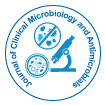

Commentary - (2022)Volume 6, Issue 3
Cryptococcosis is a potentially fatal fungal infection primarily of the lungs, manifesting as pneumonia, and the brain, manifesting as meningitis. When the lungs are infected, there is a cough, difficulty breathing, chest pain and fever. When the brain is infected, symptoms include headache, fever, sore throat, nausea and vomiting, sensitivity to light, and confusion or changes in behavior. It can also affect other parts of the body, including the skin, where it can appear as multiple fluid-filled nodules with dead tissue.
It is caused by the fungi Cryptococcus neoformans or less commonly Cryptococcus gattii and is acquired by breathing spores from the air. These fungi are found worldwide in soil, decaying wood, pigeon droppings and in the cavities of some tree species. While C. neoformans generally infects people with HIV/AIDS and those taking immunosuppressants and usually does not affect otherwise healthy people, C. gattii (found in parts of Canada and the US) does. Once inhaled, the dried yeast cells colonize the lungs, where they are either cleared by immune cells, lie dormant, or cause infection and spread.
Diagnosis
Depending on the infectious syndrome, symptoms include fever, fatigue, dry cough, headache, blurred vision, and confusion. The onset of symptoms is often subacute, gradually worsening over several weeks. The two most common manifestations are meningitis (infection in and around the brain) and pulmonary (lung) infection.
A lumbar puncture to assess the Cerebrospinal Fluid (CSF) for cryptococcal meningitis is indicated in any person who has cryptococcosis at a site outside the central nervous system (eg, pulmonary cryptococcosis), even if they have no signs or symptoms of CNS disease. Detection of cryptococcal antigen (capsular material) by culture of CSF, sputum, and urine provides a definitive diagnosis. Blood cultures may be positive in severe infections. CSF India ink is the traditional microscopic method of diagnosis, although sensitivity is low in early infection and may miss 15%-20% of patients with culture-positive cryptococcal meningitis. Unusual morphological forms are rarely seen. Cryptococcal antigen from cerebrospinal fluid is the best test for diagnosing cryptococcal meningitis in terms of sensitivity.
Prevention
Cryptococcosis is a very subacute infection with a prolonged subclinical phase lasting weeks to months in persons with HIV/ AIDS before the onset of symptomatic meningitis. In sub- Saharan Africa, the prevalence rate of detectable cryptococcal antigen in peripheral blood is often 4%-12% in persons with CD4 counts less than 100 cells/mcL. Cryptococcal antigen screening and preemptive treatment with fluconazole saves the healthcare system costs by avoiding cryptococcal meningitis.
The World Health Organization recommends cryptococcal antigen screening in HIV-infected persons entering care with CD4<100 cells/μL. This undetected subclinical cryptococcus (if not preemptively treated with antifungal therapy) will often go on to develop cryptococcal meningitis despite being treated for HIV.
Cryptococcosis accounts for 20%-25% of mortality after initiation of HIV therapy in Africa. What is effective preemptive treatment are unknown, current recommendations for dose and duration are based on expert opinion. Screening in the United States is controversial, official guidelines do not recommend screening, despite cost-effectiveness and a 3% prevalence of cryptococcal antigen in the US in CD4<100 cells/μL.
Antifungal prophylaxis, such as fluconazole and itraconazole, reduces the risk of cryptococcosis infection in patients with low CD4 cell counts and a high risk of developing cryptococcal disease if screening tests for cryptococcal antigen are not available.
Citation: Vat I (2022) Diagnosis of Cryptococcosis Infection and its Prevention. J Clin Microbiol Antimicrob. 06: 139
Received: 18-Nov-2022, Manuscript No. JCMA -22-20970; Editor assigned: 23-Nov-2022, Pre QC No. JCMA -22-20970 (PQ); Reviewed: 07-Dec-2022, QC No. JCMA -22-20970; Revised: 14-Dec-2022, Manuscript No. JCMA -22-20970 (R); Published: 21-Dec-2022 , DOI: 10.35248/JCMA.22.6.139
Copyright: © 2022 Vat I. This is an open-access article distributed under the terms of the Creative Commons Attribution License, which permits unrestricted use, distribution, and reproduction in any medium, provided the original author and source are credited.